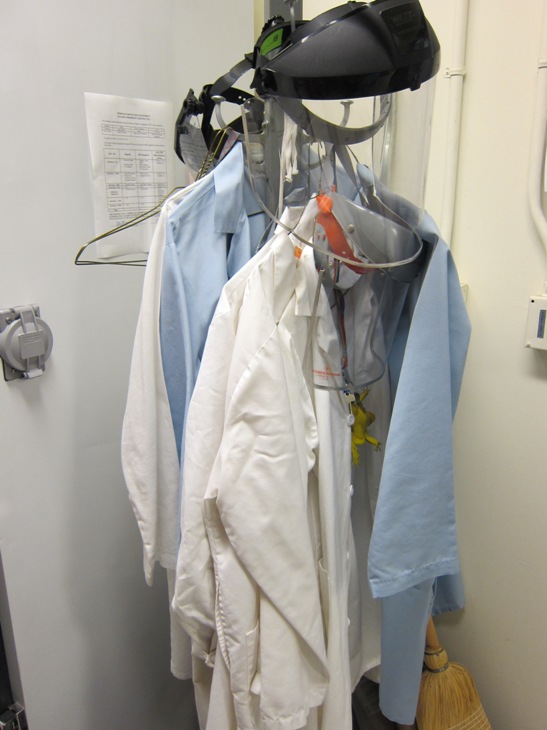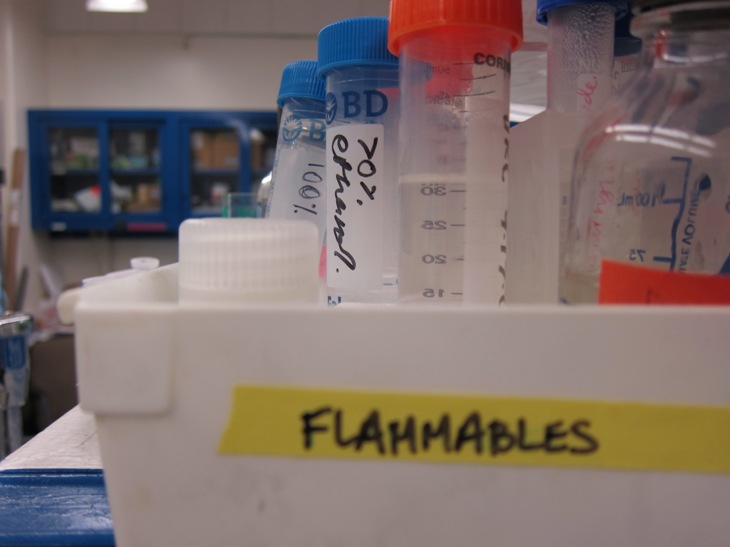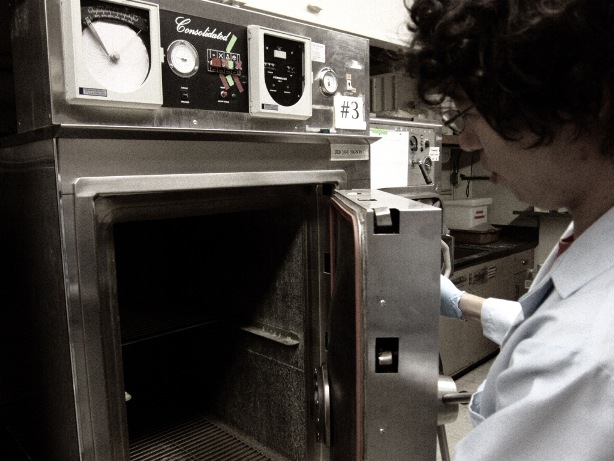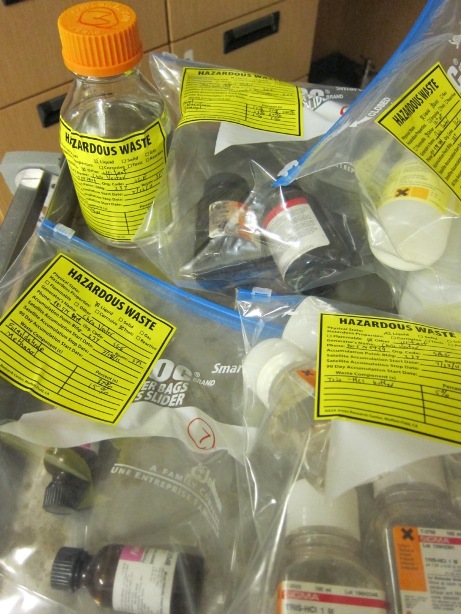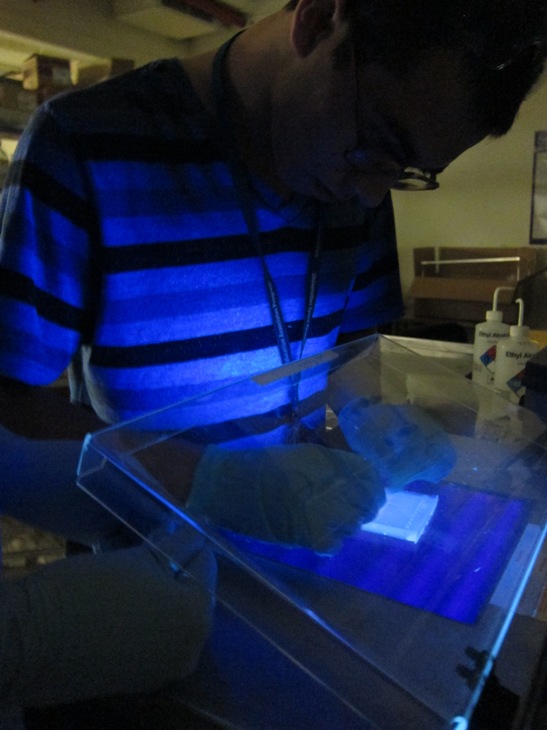Team:Brown-Stanford/Lab/Safety
From 2011.igem.org
Safety
Safety is a primary concern when conducting research in synthetic biology. We recognize that any type of work in the laboratory setting generates an element risk for us, as iGEM team members, and those in our community. To reduce this risk, we engaged in safety training and followed best practices as outlined by our respective academic institutions and by NASA. We also recognize that the nature of our work, to modify organisms and introduce novel functions, warrants additional consideration from a safety standpoint. The team carefully evaluated the potential dangers posed by our projects and took appropriate measures where necessary.
Biosafety regulations and practices
Our academic institutions have Environmental Health and Safety organizations which establish rules and regulations for proper lab practice. The team followed these guidelines, as well as those of the Occupational Health and Safety division of the NASA Ames Research Center, whenever we engaged at research. More information is available at the following websites for reference:
http://www.brown.edu/Administration/EHS/biological/
http://www.stanford.edu/dept/EHS/prod/researchlab/bio/
http://server-mpo.arc.nasa.gov/Services/CDMSDocs/Centers/arc/Dirs/APR/APR1700.1.html
Safety training
In compliance with safety regulation, team members underwent several rounds of training at our home institutions and at NASA Ames.
Prior to the summer, Brown and Stanford students all participated in courses on general lab safety/biosafety/waste disposal, gaining the requisite certification to engage in biological research with our universities.
Upon arrival at NASA, we went through the standard orientation and training process required of all interns. We attended a three hour general orientation of the research facility, which included information about occupational health and a broad overview of the safety resources available at NASA. Later on, we took part in a four hour safety “bootcamp” in which we were introduced to biological containment protocols, waste disposal, and handling of hazardous materials in the lab.
Practices
Hazardous materials containment
Although we worked with non-pathogenic strains of bacteria, we took care to contain potentially hazardous materials in the lab. Work with biological materials was carried out at BSL1 conditions. Other standard lab practices were followed, including secondary containment of chemicals, proper storage of volatiles and flammables, and separation of acids and bases.
Waste disposal
Waste contaminated with biologicals was stored in specially marked bags that were autoclaved prior to disposal. Sharps and broken glassware was also disposed of in accordance with institutional guidelines. Hazardous liquid waste was clearly labeled, stored in secondary containment in a specially cordoned off section of the lab for our lab manager to eliminate.
Alternative DNA staining
Our team used GelRed, a DNA dye produced by Biotium Inc, as a non-toxic alternative to ethidium bromide (EtBr). EtBr is one of the more common hazardous materials in molecular biology, used to stain DNA in the process of gel electrophoresis. It is an intercalating agent which inserts into double stranded DNA and is suspected to be a powerful mutagen. In contrast, GelRed has passed numerous toxicity tests outlined by government waste disposal laws (http://www.biotium.com/product/product_info/Safety_Report/GR%20&%20GG%20safety.pdf)
GelRed is safe to handle without additional precautions and can be disposed as regular trash. We thus bypassed the health risks posed by a potential carcinogen and simplified our waste management process.
Projects
For more in-depth explanation of our projects, materials, and methods, please refer to the project sections of our team wiki. Here we have considered the aspects of our experiments which could potentially pose risks beyond those typically associated with research. Commonplace materials that are found in most biology labs will receive less focus here, but were treated with equal care during the summer as part of our general safety practices. These include:
-Bacterial species and strains such as Bacillus subtilis and E. coli (HB101, DH5a, K-12, TOP10)
-Chemicals used to make buffer solutions, media, etc
-Contents of molecular biology kits (reagents for DNA extraction, enzymatic reactions, etc
Regobricks
Sporosarcina pasteurii (formerly classified as Bacillus pasteurii)
S. pasteurii does not possess any known pathogenic traits or behaviors. We are currently attempting to transform this organism with multiple different Bacillus subtilis shuttle vectors that confer antibiotic resistance and GFP expression, which in turn allow us to select for transformants. Apart from establishing standard antibiotic resistance, our transformations of S. pasteurii will in no way increase or alter the environmental tolerance of the organism, nor will they introduce human or environmental toxicity or pathogenicity.
JSC-1 Lunar Simulant & JSC Mars-1 Martian Simulant
Both JSC-1 Lunar Simulant and JSC Mars-1 Martian Simulant are produced by Orbitec Technologies Corporation for planetary research purposes. According to the MSDS safety sheets supplied by Orbitec, both simulants have no identified environmental effects, are neither fire nor explosive hazards, and have no special instructions for or warnings against accidental release.
Concerning human health and exposure, both simulants may cause irritation to the eyes and respiratory tract after prolonged exposure to airborne dust. While no special containment or precautions are designated for storage and handling of these simulants, all our work with them in our lab was performed in a fume hood to minimize exposure to airborne dust.
Urease operon
The urease operon we work with was originally acquired from the genome of S. pasteurii and contains only the genes responsible for the expression and activity of the urease protein. The urease operon was inserted into the common E. coli plasmid backbone pBR322 and transformed into E. coli, in which it expressed urease. These E. coli accordingly displayed ureolytic activity and antibiotic resistance (from the pBR322 backbone), but were not modified in any other way and do not pose any heightened health or environmental risk.
Powercell
Anabaena PCC 7120 and Nostoc punctiforme
Our two model organisms are strains of freshwater filamentous cyanobacteria. Neither are known to possess any known pathogenic traits. Our attempts to transform these species with a shuttle vector and our sugar secretion construct does not introduce any DNA that increases host range or toxicity. Sugar and nitrogen secretion would present a metabolic disadvantage to our engineered strains, if our strains are accidentally released into the environment.
Escherichia coli W (ATCC 9637)
E. coli W is a strain able to survive on sucrose as a sole carbon source. It is non-pathogenic, making it similar to other common strains of E. coli (DH5a, TOP10, etc) with respect to safety concerns. The addition of constructs such as bioluminescence serves only as a demonstration of gene expression under sucrose-only conditions, and does not alter the health and environmental impact of our microbe.
Synthetic construct
Our cyanobacterial construct consists of a sucrose permease gene from E. coli W and a GFP reporter, under the control of an endogenous vegetative cell-specific promoter. The sucrose permease is a transport channel for sucrose, a non-toxic and readily accessible compound outside of the lab. Our construct’s function is to raise or decrease sucrose levels in our small scale culture, which will not impact cells that have not been deliberately starved of alternative carbon sources (a situation not found in nature). In the event of horizontal gene transfer, or inadvertent expression inside the E. coli we use to clone, our construct would only present a metabolic disadvantage.
FRETcetera
Synthetic constructs
We do not believe that our BioBrick parts will have any negative effect on the environment. None of our parts should cause the strains to gain any harmful attributes. In our Biosensor project, our parts are components of bacterial extracellular matrix that digests cellulose and other sugars. These proteins are already present in the nonpathogenic strains of E. coli and is unlikely to be harmful if expressed inside the cell. Using cohesin and dockerin from the cellulosome for novel applications in research is an established field (cite).
All of our materials and parts pose no human health risk in terms of pathogenicity, toxicity, or infectivity; nor do they represent any risk to the environment or to the safety or security of the world at large.
 "
"








